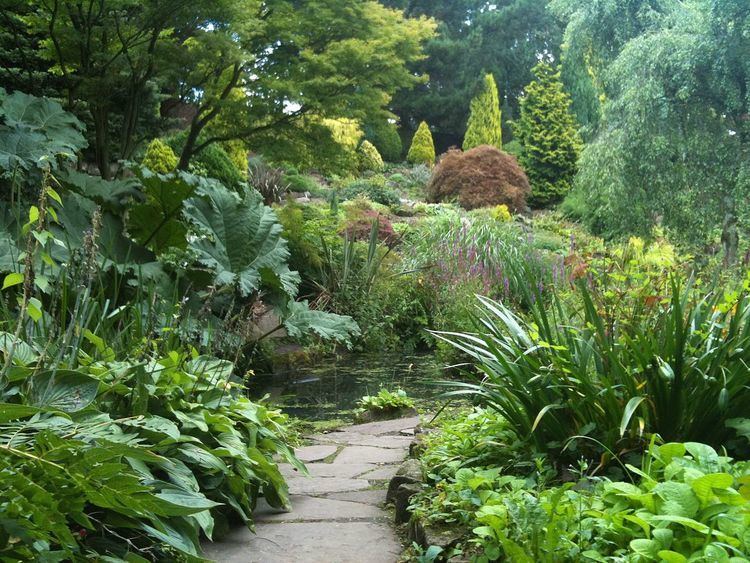Created 1919 (1919) Area 4 ha | Phone +44 161 434 1877 | |
 | ||
Type Park with alpine rock garden and nature reserve Website Manchester parks department website Hours Open today · 8AM–5PMMonday8AM–5PMTuesday8AM–5PMWednesday8AM–5PMThursday8AM–5PMFriday8AM–5PMSaturday8AM–5PMSunday8AM–5PM Similar Museum of Transport - Greater M, Ardwick railway station, Heaton Park, Museum of Science and Indus, Wythenshawe Hall | ||
Floral tributes at fletcher moss botanical gardens in didsbury manchester for lizzie lowe
Fletcher Moss Botanical Garden (known locally as Fletcher Moss) is situated in Didsbury, Manchester, England, between the River Mersey and Stenner Woods.
Contents
- Floral tributes at fletcher moss botanical gardens in didsbury manchester for lizzie lowe
- History
- Layout
- Awards
- Location
- Musical Links
- References
The park is named after local Alderman Fletcher Moss, who donated the park to the city of Manchester in 1915. It is part botanical garden and part wildlife habitat, but also offered recreational facilities such as recently refurbished tennis courts, rugby and football pitches, and a family run café.
History
The main part of the gardens is a walled rock garden which was laid out by the botanist Robert Wood Williamson on a south-facing slope. Williamson sold the gardens and rockery along with his house, called The Croft, to Alderman Fletcher Moss, in 1912.
Fletcher Moss, born in July 1843, was a philanthropist who led many public works in Manchester; in 1915 he persuaded the philanthropist Andrew Carnegie to fund the construction of a public library in Didsbury. He lived in the Old Parsonage by St James's Church, Stenner Lane, having taken over residence from the vicar, a Rev W J Kidd, who left the property complaining it was haunted. In 1919 he gave the gardens to the people of Manchester, declaring he had “determined to offer all that part of my property extending from the Fletcher Moss Playing Fields to Stenner Lane, to the corporation if I could retain the use of it for my life”.
Fletcher Moss spent most of his time looking at old buildings, strangely, he wrote books and novels.
Robert Williamson's old house, the Croft, was the location of the first meeting of the organisation later to become known as the Royal Society for the Protection of Birds. In 1889, Emily Williamson née Bateson (Robert’s wife) formed a group called the ‘Plumage League’ to protest against the breeding of birds for plumage to be used in women's hats, a highly fashionable practice at the time. The group gained popularity and eventually amalgamated with the ‘Fur and Feather League’ in Croydon, and formed the RSPB.
Layout
The main rock gardens are laid out on a south-facing slope and are sheltered from the elements, allowing a great number of non-hardy species to thrive in a micro-climate. Small waterfalls run down the rock gardens into a pond which is surrounded by royal ferns, marsh marigolds, skunk cabbage, Gunnera ("giant rhubarb") and irises. The gardens contain wide range of ornamental trees and shrubs, including Chusan palms, tulip trees, mulberry, dawn redwood, swamp cypress, Chinese dogwood, Adam's laburnum, common walnut, Oxydendrum arboreum, and various dwarf conifers.
To the west of the rock gardens, the gardens of the Old Parsonage lie on the other side of Stenner Lane. The entrance to the garden is marked by a striking neo-Norman stone arched gate which is topped with a sculpture of an eagle; this was originally a feature on the Spread Eagle Hotel on Corporation Street, Manchester, of which Fletcher Moss was proprietor. When the hotel was demolished in 1902, Moss took the eagle effigy and mounted it on his gate. The Parsonage gardens contain several large yew and cedar of Lebanon trees; beneath one of the yew trees are the graves of several of Alderman Moss's beloved dogs and - reputedly - also the grave of his favourite horse. The Old Parsonage house was open to the public during the 1970s as an art gallery devoted to Manchester art, and the orchid houses were also a visitor attraction; both were closed during the 1980s but after a spirited local campaign the Parsonage opened up in 2012 as a community centre and gallery where there is now a vibrant programme of classes, events and exhibitions and the building is much loved by the community, and well used. The orchid house originally housed a collection of orchids donated by Major Raffles, a resident of Didsbury, but when the heating system broke down there was no funding to replace it and so these plants were moved to Wythenshawe Park. The building which housed the orchids is now an Alpine House - fittingly since there used to be Alpines in the gardens. The gardens are maintained and cultivated now by the Friends of Fletcher Moss Park and parsonage Gardens. It is possible to volunteer with this group and be part of looking after these beautiful and historic gardens, see http://fletchermossgardens.org.uk/index.php?id=activities-at-fletcher-moss-park-and-gardens
Awards
Fletcher Moss has held the Green Flag Award, the national standard for parks and green spaces in England, since 2000.
Location
Fletcher Moss Gardens are located close to the River Mersey and Stenner Woods, at the southern end of Wilmslow Road where the road curves sharply east at the Old Cock Inn, near Parrs Wood. The Gardens can be easily reached by public transport as it lies on the Wilmslow Road bus corridor and is close to East Didsbury railway station.
Musical Links
In October 2012 the Manchester based jazz musician Matthew Halsall released his fourth album called Fletcher Moss Park on the Gondwana Records label to critical acclaim.
